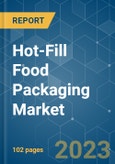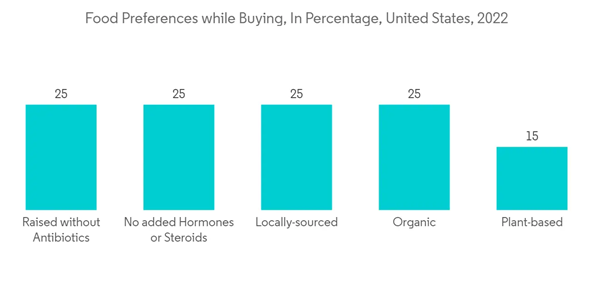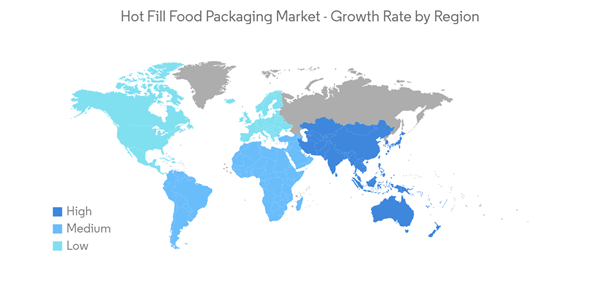Key Highlights
- The COVID-19 pandemic-related lockdown brought about a significant shift in consumption patterns. The demand for hot-fill packaging has increased due to the food's safety, sterilization, and sanitization; as a result, manufacturers are attempting to introduce new techniques and products to meet consumer demand.
- In the case of the food and beverage packaging industry, sustainable packaging and longer shelf life are of great importance to the consumer. As a result, most of the food and beverage vendors across the world are inclining towards hot-fill packaging, along with cost and environmental benefits in consideration, especially in terms of shipping and storage.
- The growth in the hot-fill food packaging market is also majorly driven by the ability of the packaging products to respond to the need for high and uniform product quality and the need for higher nutrient retention. However, the market has also been challenged by the fact that the hot-fill procedure also results in changes in taste, color, etc., in some food and beverage products.
- Changing lifestyles and the consequent dependence of consumers on processed, packaged, and pre-cooked food is increasing the demand for hot-fill packaging solutions. The advent of the supermarket culture has also altered the shopping landscape and increased the need for packaging, especially in food and beverage products. The altering lifestyle of people has resulted in the shift from home cooked to ready-to-eat products.
- Food packaging has no longer just a passive role in protecting and marketing a food product. The emphasis on the decrease of preservatives is also a driving factor for the use of hot-fill packaging as a food preservation method that enables processed food to be kept for a longer period without preservatives, as long as they are not opened.
Hot-fill Food Packaging Market Trends
Harmful Effects of Preservatives Used in Beverages
- Packaged beverages frequently have excessive sugar or harmful artificial sweeteners like saccharine or aspartame. They also include other dangerous preservatives that can cause metabolic disorders, high blood pressure, diabetes, abnormal cholesterol, excess body fat, and weight gain.
- The primary factor anticipated to drive the market during the projected period is the rising public awareness about the harmful effects of beverage preservatives. Sales of hot-fill packaging have increased due to the rising demand for preservative-free goods. Furthermore, it is anticipated that another significant factor driving up demand for hot-fill packaging in the future would be its capacity to prevent microbial development.
- Longer shelf lives, fewer preservatives, and less food waste are advantages that hot-fill packaging offers to fruit juice producers and other high-acid beverages. Moreover, various studies, including a survey conducted by IFIC, stated that people are more inclined towards natural and preservative-free food and beverages.
- Hot-fill pouches are widely used as an alternative to conventional industrial canning techniques to pack the ready-to-eat food market. These pouches enable the sterile packing of various fresh, cooked, or semi-cooked foods, juices, and beverages. Due to the ease of storage and immediate consumption of heated food inside the pack, the utility of hot-fill pouches has exceeded consumer expectations.
- The beverage sector has seen tremendous growth in hot-fill packaging. The shelf life of hot-fill packaging is extended when PET bottles are used. This type of packaging has a shelf life of around 6 to 12 months and is appropriate for packaging non-carbonated beverages, soft drinks, and water. Due to the large production volume and user-friendliness, the bottle sector is anticipated to dominate the market. The increased demand for the bottle may reduce the pouch product selection as product type.
Asia Pacific is Expected to Hold the Largest Market Share
- Consumers in the region have been shifting towards hygienic and healthier food products, and they have been demanding healthy beverages, fruit drinks, etc. The increasing demand from the food and beverage industry is expected to generate the demand for hot-fill packaging in the region.
- Supermarkets and online stores are also increasingly becoming an important source of packaged food and beverages in the region. For instance, e-commerce and supermarkets are gaining space in China, where most of the population relies on fast distribution channels to obtain ready-to-eat products at their convenience, which has also been aiding the growth of the hot-fill packaging market.
- Moreover, the COVID-19 pandemic is expected to increase the use of hot-fill packaging across various countries in the region. Developing countries such as China and India have low consumption per capita of flexible packaging for fresh and processed meat and seafood compared to Japan, the United States, and Western Europe. Growing urbanization and changing lifestyles in these developing countries are also helping to drive the demand for hot-fill packaging.
- Some of the major factors anticipated to propel the Asia-Pacific hot-fill packaging market include rising health awareness, a rise in consumer demand for preservative-free products, and the low cost of hot-fill packaging. Additionally, the market is anticipated to see significant growth due to recent innovations and new product launches, the rise in instances of food contamination, low costs, and other benefits offered by hot-fill packaging.
- In addition, investments in hot-fill packaging by major beverage players are anticipated to propel the market growth in Asia-Pacific. For instance, in September 2021, Uflex, Mespack, and Hoffer Plastics collaborated to develop a turnkey solution that enables 100% recyclability of hot-fill pouches with its new mono-polymer structure, bringing many environmentally conscious brands closer to achieving their sustainability goals.
Hot-fill Food Packaging Market Competitor Analysis
The hot-fill food packaging market is moderately competitive. Major players with a significant market share are expanding their customer base across various regions. In addition, many companies are forming strategic and collaborative initiatives with multiple companies to increase their market share and profitability. Some of the recent developments in the market are:- August 2022: Amcor PLC AMCR launched a modern innovation hub in Jiangyin, China, to provide customers in the Asia Pacific region with advanced packaging technologies and eco-friendly material science. Amcor continues to invest in growth and expand capacity in higher growth, higher value-added, as well as more packaging-intensive segments like hot-fill beverage packaging, supported by its strong balance sheet and an annual free cash flow of over USD 1 billion.
- May 2022: A new line of hot-fill sauce bottles was introduced by Berry Global that maximizes consumer convenience while maintaining an appealing on-shelf appearance. The Nova bottle, which comes in 250ml and 500ml sizes, is made of clear polypropylene (PP) and has a contemporary curved design. It has a large labeling area for better product branding and is simple to handle for end-users.
Additional benefits of purchasing the report:
- The market estimate (ME) sheet in Excel format
- 3 months of analyst support
This product will be delivered within 2 business days.
Table of Contents
Companies Mentioned (Partial List)
A selection of companies mentioned in this report includes, but is not limited to:
- Amcor PLC
- San Miguel Yamamura Packaging Corporation
- Berry Global Inc.
- Crown Holdings Inc.
- Scholle IPN Corporation
- Graham Packaging Company
- MJS Packaging
- Imperial Packaging
- Novolex
- The Cary Company
- The Vanee Foods Company










